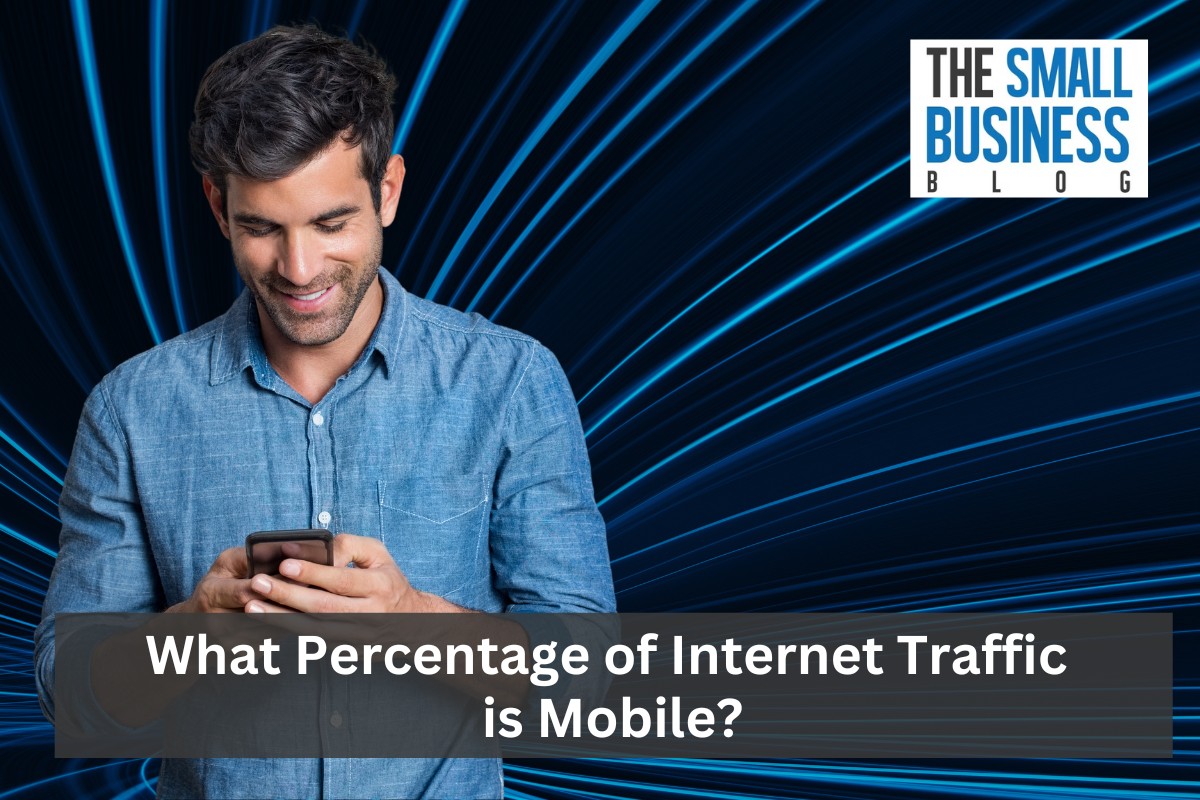There’s no doubt that you are reading this article from your computer or your smartphone.
Today, we are going to learn what percentage of internet traffic is mobile.
We have researched the statistics and FAQs to bring you the most recent and reliable information possible.
Everywhere we look nowadays we see people walking around looking at their smartphones, texting, watching videos, playing games, using apps to buy food and beverages, etc.
Today’s society is obsessed with mobile phones and using them to access the internet.
Today, a large percentage of internet traffic comes from mobile phones.
In fact, mobile phone traffic accounts for 58.33% of all internet usage today.
So, until even more convenient and user-friendly tech comes along, mobile phones are today’s easiest and most used options for going online.
Let’s find out more about how mobile traffic is changing the world.
Post Contents
- 1 What Percentage of Internet Traffic is Mobile in 2024?
- 1.1 1. 58.33% of all internet traffic comes from mobile phones.
- 1.2 2. The total share of mobile internet traffic comes to 67.81%, as of May 2023.
- 1.3 3. In 2022, sending messages and chatting accounted for 74.7% of mobile phone usage.
- 1.4 4. Ad viewability on mobile is 83% compared to only 53% on desktop.
- 1.5 5. Tablets have a bounce rate of 42%, which is lower than mobile and desktop.
- 1.6 6. Mobile’s share of internet traffic has grown around 50% since 2012.
- 1.7 7. In the United States, desktop traffic still outweighs mobile phone and tablet traffic.
- 1.8 8. In India, mobile internet traffic has a huge share at 79.53%.
- 1.9 9. 6.92 billion people across the globe have smartphones.
- 1.10 10. 7.33 billion people in the world use mobile phones.
- 1.11 11. In terms of being connected, there are 11.701 billion IoT cell connections.
- 1.12 12. Over the past 12 months, Europe’s mobile traffic accounts for 51.79% of internet traffic.
- 1.13 13. North America has a market share of 33.67% in mobile internet traffic.
- 1.14 14. In 2023, over 92.30% of online users in the U.S. accessed the internet via mobile phones.
- 1.15 15. Between 2017 and 2022 worldwide smartphone users rose by 49.89%.
- 1.16 16. It’s expected that 72% of all online users will access the web exclusively via smartphone by 2025.
- 1.17 17. 56.7% of smartphone users search for products online.
- 1.18 18. $511.8 billion in ecommerce retail sales came from mobile users in the United States.
- 1.19 19. 62% of organic searches produce unique results on mobile and desktop devices.
- 1.20 20. Year-over-year, mobile phone subscriptions have risen from 34 million in 1993 to over 8.6 billion in 2023.
- 2 FAQs
- 2.1 How much web traffic comes from mobile devices?
- 2.2 What are the activities most done on mobile phones?
- 2.3 How many websites aren’t optimized for mobile?
- 2.4 What mobile online activities require the most data?
- 2.5 What is the future of mobile internet traffic?
- 2.6 How much time is spent on mobile phones?
- 3 Conclusion
Key Statistics
- 58.33% of all internet traffic comes from mobile phones.
- The total share of mobile internet traffic comes to 67.81%, as of May 2023.
- In 2022, sending messages and chatting accounted for 74.7% of mobile phone usage.
- Ad viewability on mobile is 83% compared to only 53% on desktop.
- Tablets have a bounce rate of 42%, which is lower than mobile and desktop.
- Mobile’s share of internet traffic has grown around 50% since 2012.
- In the United States, desktop traffic still outweighs mobile phone and tablet traffic.
- In India, mobile internet traffic has a huge share at 79.53%.
- 6.92 billion people across the globe have smartphones.
- 7.33 billion people in the world use mobile phones.
What Percentage of Internet Traffic is Mobile in 2024?

Let’s discuss mobile online traffic.
1. 58.33% of all internet traffic comes from mobile phones.
Mobile internet traffic has now overtaken desktop/laptop internet traffic with over half of the share.
Mobile accounts for 58.33% of all web traffic across the globe as of the first quarter of 2023.
(Statista)
2. The total share of mobile internet traffic comes to 67.81%, as of May 2023.
Data from May 2023 shows that the share of all mobile internet traffic accounted for 67.81%.
This accounts for an average of 58.33% from mobile phones.
Moreover, mobile internet traffic is overshadowing desktop by over 10%.
The desktop share of internet traffic averaged 42.22% over the past 12 months.
(Oberlo, StatCounter)
3. In 2022, sending messages and chatting accounted for 74.7% of mobile phone usage.
People use the internet for many activities and two include sending messages and online chatting.
In 2022, Statista revealed that 74.7% of mobile internet usage involves chatting online or sending online messages.
The growth of social media and messaging apps has likely played a role in this statistic.
(Statista 2)
4. Ad viewability on mobile is 83% compared to only 53% on desktop.
In terms of PPC ads used by advertisers, video ads viewability mobile users account for 83%, while only 53% of desktop users.
All those desktop ad blockers and browser ad blockers prevent people on desktop/laptop from seeing video ads more than half of the time, the mobile audience is much more likely to see video ads.
(Business2Community)
5. Tablets have a bounce rate of 42%, which is lower than mobile and desktop.
Out of mobile phone, desktop, and tablet bounce rates, tablets have the lowest at 42%.
Desktops are second to tablets at 45% and mobile phones have a 49% bounce rate and are the fastest.
The difference in bounce rates between tablets and mobile phones only accounts for 7%, which may be why people stay on the tablets longer than their phones.
(DataProt)
6. Mobile’s share of internet traffic has grown around 50% since 2012.
In 2012, mobile traffic had a 10.88% share of all internet traffic, which increased to 54.09% by 2017.
Now it’s steadily seeing growth, but the growth has slowed since 2017.
Today, at an average of between 56% and over 60%, we have seen over 50% overall growth since 2012 with some fluctuations.
(How Sociable, Oberlo)
7. In the United States, desktop traffic still outweighs mobile phone and tablet traffic.
As of June 2023, the desktop share of internet traffic accounted for 66.57%, while mobile phone had a 31.7% share and tablet a 1.73% share.
While this is what’s happening in the United States, it’s different at the global level.
(StatCounter)
8. In India, mobile internet traffic has a huge share at 79.53%.

In contrast to the United States where desktop traffic rules the internet still, 79.53% of all internet traffic in India comes from mobile phones.
If you add tablets to that, it’s another 0.44%, making a total mobile internet traffic share of 79.97%, which is nearly 80% of internet traffic.
Desktop internet traffic is only 20.03% in India.
(StatCounter)
9. 6.92 billion people across the globe have smartphones.
According to the statistics, 6.92 people in the world use smartphones, which represents 86.11% of the world’s population.
In comparison, only 49.40% of the global population used smartphones in 2016.
That accounts for 3,668 billion smartphone users.
This says a lot about how much mobile internet traffic has grown.
(Bank My Cell)
10. 7.33 billion people in the world use mobile phones.
Not every mobile phone is a smartphone, so we have another figure for mobile phone users which is 7.33 billion.
That accounts for 91.21% of the global population.
This includes feature phones and smartphones combined.
Therefore, this is how many people use mobile phones in the world.
(Bank My Cell)
11. In terms of being connected, there are 11.701 billion IoT cell connections.
When speaking of cellular connections, the world now has 11.701 billion connections, which outnumbers the whole global population which is 8.036 billion.
So, there are over 3 billion more mobile connections than there are people in the world.
(Bank My Cell)
12. Over the past 12 months, Europe’s mobile traffic accounts for 51.79% of internet traffic.
In Europe, 51.79% of all internet traffic comes from mobile phones and another 2.47% from tablets.
Desktop accounts for 45.74% of internet traffic.
Europe also outweighs the United States in this realm even if it’s by only few percentage points.
(StatCounter)
13. North America has a market share of 33.67% in mobile internet traffic.
North America, like the United States, has a larger share in the desktop internet traffic market than in the mobile sector.
This region’s share of the mobile internet traffic market accounts for 33.67%, plus 1.88% from tablets.
(StatCounter)
14. In 2023, over 92.30% of online users in the U.S. accessed the internet via mobile phones.
Out of 100% of all online users in the United States, a whopping 92.30% went online using their mobile phones.
This year the number of internet users has grown with new users and existing users going online through mobile phones, including smartphones.
(Demand Sage)
15. Between 2017 and 2022 worldwide smartphone users rose by 49.89%.
According to our sources, the worldwide percentage of smartphone users grew by 49.89% between 2017 and 2022.
If you recall, between 2012 and 2017, mobile usage grew by over 50%.
With more people getting smartphones, it’s inevitable that mobile internet traffic will also continue to rise.
(Bank My Cell)
16. It’s expected that 72% of all online users will access the web exclusively via smartphone by 2025.
As smartphone adoption grows, it would only make sense that people will use their phones to access the internet.
In 2022, it’s expected that 72% of web users will be accessing the internet exclusively by mobile smartphones.
(Bank My Cell)
17. 56.7% of smartphone users search for products online.
One of the ways mobile users use their smartphones is to search for products.
Another 43.3% use their phones for price comparisons among brands and products.
Visiting websites that offer special deals accounts for 37.9% of smartphone online usage.
In terms of looking for products, smartphone users also go online to write reviews about products at 21%.
(Statista 2)
18. $511.8 billion in ecommerce retail sales came from mobile users in the United States.

Data from 2023 tells us that $511.8 billion in ecommerce retail sales came from mobile users.
People aren’t just using their mobile phones to research products, write reviews, and look for deals.
They are also making purchasing decisions and buying from retailers online from their mobile devices which includes smartphones and tablets.
(Demand Sage)
19. 62% of organic searches produce unique results on mobile and desktop devices.
What this means is that what you get from an organic search depends on the device upon which you search.
While not all organic searches display different search results, 62% organic searches do.
This also means that content is optimized for different devices.
So, in 38% of organic searches, you may be poor results on your smartphone.
(How Sociable)
20. Year-over-year, mobile phone subscriptions have risen from 34 million in 1993 to over 8.6 billion in 2023.
We already mentioned that mobile device usage on the internet has fluctuated over the past few years and growth has slowed somewhat, but mobile phone subscriptions are still growing.
The fact that people are on average spending 3 hours and 15 minutes on their mobile phones each day tells us that internet traffic from mobile phones will keep growing.
(Exploding Topics, Exploding Topics 2)
FAQs
How much web traffic comes from mobile devices?
In terms of global internet traffic, 58.33% accounts for mobile devices.
In the United States, 47.79% accounts for mobile devices.
This is data from 2023. These statistics give us a good indication that people all over the world are using mobiles more than ever.
What are the activities most done on mobile phones?
According to Statista, in 2022, 74.7% of people used their phone for chatting or sending messages.
Second to that, 70.95% of mobile phone users were using their phones for emailing others.
Online banking is third at 62.9% and listening to music came in fourth at 61.1% and tied with watching videos.
How many websites aren’t optimized for mobile?
Approximately 24% of the top one million most popular websites aren’t mobile-friendly.
If you’re a marketer and have a client whose site isn’t optimized for mobile, encourage them to make that happen.
The above statistics should help you get them to see the light.
What mobile online activities require the most data?
Surfing via a web browser from your phone isn’t the answer.
The answer to this question is apps.
Apps are more likely to use up your mobile data faster.
Streaming apps like Spotify, Netflix, Facebook, Twitter, and other social media apps can drain your data fast.
What is the future of mobile internet traffic?
As the demand for mobile data across the globe grows, experts conservatively predict that there will be an increase in demand of 3 to 10 times what it is today by 2030.
Additionally, they expect to see 9,000 to 25,000 petabytes being used by 2030.
That accounts for an average monthly usage of between 27 and 75 gigs per mobile subscriber in 2030.
How much time is spent on mobile phones?
On average, people spend a total of 49 days a year just looking at their mobile phones, which translates to about 3 hours and 15 minutes per day.
Some users admit to using their mobile phones for 5 hours per day, which translates into 76 days per year.
The more hours per day you spend on your phone racks up the number of days per year you’re on it.
Conclusion
Now we know that at the global level, mobile internet traffic is taking over desktop internet traffic even if it’s just a few percentage points.
Desktop is still king in the United States in terms of internet traffic, but in India, mobile internet traffic rules.
We also discovered that mobile internet traffic has risen over 50% in the past 11 years.
However, most of that growth occurred quickly between 2012 and 2017 as it’s on a steadier, slower growth path today.
We hope you have gotten something of value from reading what we found about what percentage of internet traffic is mobile.






























